
Features
Production
Research
Investigating fertigation in Ontario apple orchards
in Ontario apple orchards
April 23, 2008 By Martin Kiefer
In the spring of 2007, a group of
apple growers within Norfolk County in southern Ontario got together to
discuss whether fertigation in the orchard would be a practical
economic alternative or addition to current methods of fertilizer
application.
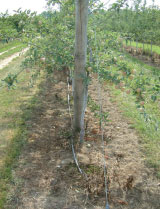 |
| When contemplating fertigation in the orchard, the drip irrigation system has to be balanced by zone with each tree receiving the same amount of water as trees in the next row or rows away. An unbalanced system means the drip line cannot deliver the correct level of nutrition to trees – under-fertilizing some trees and over-fertilizing others – with deleterious results. |
In the spring of 2007, a group of apple growers within Norfolk County in southern Ontario got together to discuss whether fertigation in the orchard would be a practical economic alternative or addition to current methods of fertilizer application.
Their reasoning was twofold. First, each of these farmers had trickle irrigation in their orchard and, with the experience of past years, had come to recognize that trickle irrigation would have growing importance in providing adequate water supply to the trees. Second, with the rising cost of base nutrients and increased focus on water quality, these growers wondered if similar results could be obtained in the orchard with lower levels of fertilization, applied when required, and at a cost equal to or less than current ground application methods.
From my perspective, employed as the agriculture sales manager at Plant Products Co. Ltd., I was interested in understanding why fertigation was not more widely used in orchards in Ontario, given its prevalence in the vegetable and small fruit industry worldwide. I met with the group of Norfolk apple producers and we established our objectives, setting out to determine how to approach fertigation in the orchard.
There were some primary conditions to be met before we considered fertigation. The drip irrigation system had to be balanced by zone. In other words, the growers had to guarantee that each tree would receive the same amount of water as an adjacent tree in the next row or rows away. An unbalanced system meant the drip line would not deliver the correct level of nutrition to trees – under-fertilizing some trees and over-fertilizing others – which could have significant deleterious results. Two of the Norfolk growers had such systems and were confident to go ahead with a fertigation program.
Next, there needed to be a way to apply the fertilizer materials in a manner that was effective, efficient, and not subject to produce materials or residues that could potentially clog the emitters. Injection of fertilizers into irrigation systems is typically done using a proportional injector or a venturi injector. Each system has specific advantages and, as it turned out, we were able to work with both systems. One of the co-operators had a Dosatron proportional injector and the other had a venturi injector.
Finally, any fertilizer used in fertigation – the nitrogen, potassium and phosphorus – had to be highly water soluble and of high purity to guarantee the complete mixing in the irrigation water without fear of residues or precipitates that would clog the emitters in the system.
These conditions met, we turned our attention to the next critical component of fertigation – what rate to use? Orchard nutrition is a measure of balance, involving soil type, cropping characteristics, variety and age of a planting, to set the correct rate of nitrogen, phosphorus and potassium to apply. As such, it can be considered part art and part science with standard rates not necessarily applying from one orchard to the next. One of the group’s key objectives was to determine what percentage of the conventional, ground applied rate would be required when using fertigation. We agreed to follow a Michigan State University recommendation of 40 per cent of the normal ground applied rate.
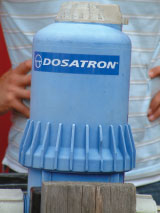 |
| One of the apple producers taking part in the fertigation project used a Dosatron proportional injector to handle the addition of liquid fertilizers. |
Timing of application was the next consideration. Traditionally, nitrogen fertilization is completed in April or early May before blossom. However, this timing is used to allow time for nitrogen fertilizers to be moved from the soil surface into the root profile and, depending on the nitrogen source used, for the nitrogen to be converted to a usable form for the roots to pick up. Research has shown that the tree uses stored nitrogen and potassium from the previous year for the first flush of growth in the spring – i.e., during bloom. Consequently, we were confident that we could delay our first application of nitrogen until bloom. We decided to split our total nitrogen requirements over six weekly applications from bloom on. This would allow the tree to set terminal bud at the normal time without encouraging excessive growth.
It is not as critical, nor desirable, to limit potassium application to the initial flush of growth in the spring and early summer. We decided to apply the potassium over 12 weeks starting with the nitrogen applications (to maximize the efficiency of application) and ending sometime in August. There was no need for phosphorus application as initial tests showed soil levels were sufficient in both orchards.
To measure the effectiveness of the fertilizer application, we chose to take leaf samples for analysis once each month during June, July and August. The test results in June at one of the orchards showed high levels of nitrogen on Gala, so the decision was made to modify the fertigation program and move over to a complete fertilizer at a very low rate. On another orchard, we continued with the program as initially planned. The leaf analysis was critical to measuring one of our objectives – that of determining if fertigation could provide sufficient nutrition to the tree despite application rates of 40 per cent of norm. Our leaf analysis results in 2007 indicated sufficient levels of all major nutrients in the plant throughout the growing season.
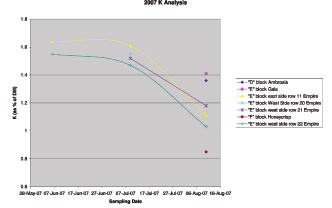 |
| Leaf analysis taken from June to August 2007 at one of the Norfolk County orchards taking part in the trial. Potassium was applied at 0 kg/ha and 40 kg/ha to the different zones under fertigation. |
Conclusions
The results achieved in 2007 would indicate that our trial in orchard fertigation was a success. We achieved our primary objectives – leaf analysis showed sufficient nutrient levels despite a 40 per cent reduction in use of nitrogen and potassium through fertigation versus normal ground application and fertilization through fertigation could be achieved at an economically sound cost.
We also learned some invaluable lessons in fertigation. As indicated above, the first and most important step is ensuring adequate system preparation in layout and in equipment. As we discovered, next in importance is to have an efficient system to inject fertilizer across multiple zones throughout the day. It was very costly in terms of time to fertigate because of the management that was required.
Our plans for 2008 are to continue the fertigation program using similar rates but with improvements in application technology to minimize the intense labour requirements. This may involve installing new valves to control the injection of fertilizer from a bulk storage system. We will also continue to monitor leaf analysis levels to ensure adequate levels of fertility. Tree fruit nutrition is a reflection of current and past fertility programs: continuing the leaf analysis program will ensure that we are not placing the trees in a deficit situation on any nutrient.
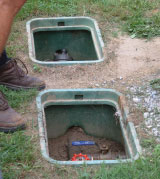 |
| The orchard’s drip irrigation/fertigation system utilized permanent underground piping (top) and an electronic timing system (bottom) to ensure proper delivery of the necessary nutrients. |
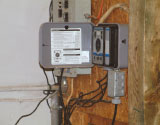 |
We also will be carefully watching the impact of fertigation on crop load and quality. Our results from 2007 would indicate that there was no impact, either positive or negative, on crop yield/quality as a result of the fertigation program. Next steps in fine-tuning our fertigation program are to look at timing of application of fertilizers. What impact can we have on yield depending on the rate and date of application? Application of fertilizers was split equally across all weeks. Perhaps there is merit in applying a higher rate during a key physiological period to achieve greater results.
Previous work on fertigation has not shown a significant impact on tree nutrition, but perhaps that was because research was done focusing on only one component of the tree nutritional program. What impact can we have if we approach the concept holistically, considering adequate nutrition, adequate soil moisture levels and plant health? If one were to commit to a fertigation program in an orchard, how can irrigation be justified if there is more than an adequate level of soil moisture – as in a year with high levels of rainfall? The opposite could also be true – in a year when crop load is off the anticipated normal, fertigation offers the flexibility to increase or decrease the application of key nutrients to quickly and more accurately reflect the needs of the tree. In that way, undesirable characteristics such as excessive growth or crop stress can be better managed.
Our fertigation programs in two Ontario orchards were not without challenges this past year. But, our results would indicate that fertigation might prove to be a suitable alternative to conventional fertilization, with potential environmental benefits at no
greater expense.
Martin Kiefer is a certified crop advisor (CCA) in Ontario and an agriculture sales manager at Plant Products Co. Ltd.
Print this page